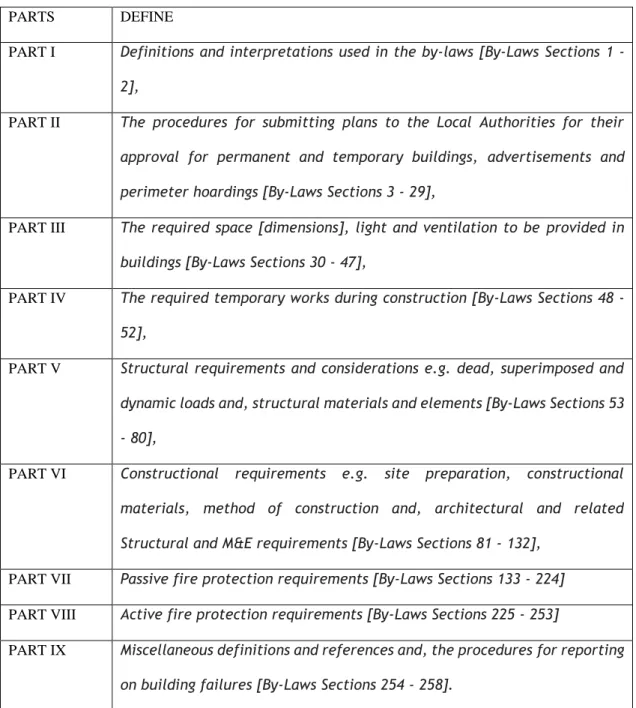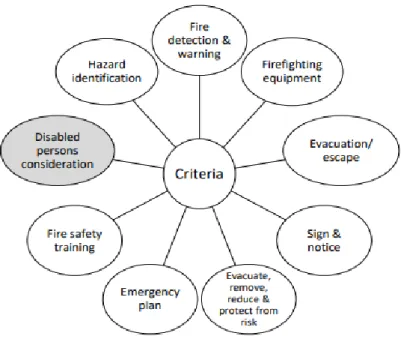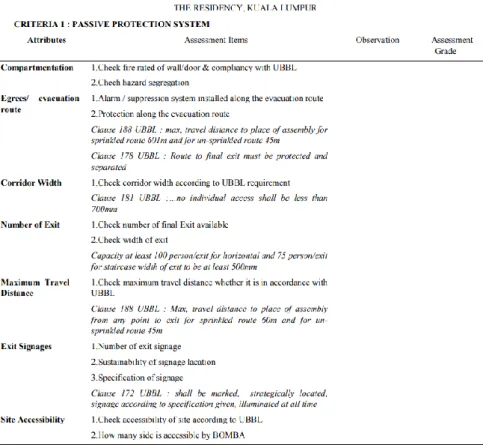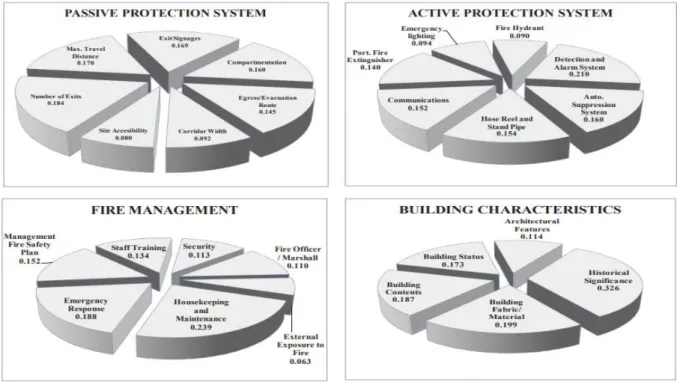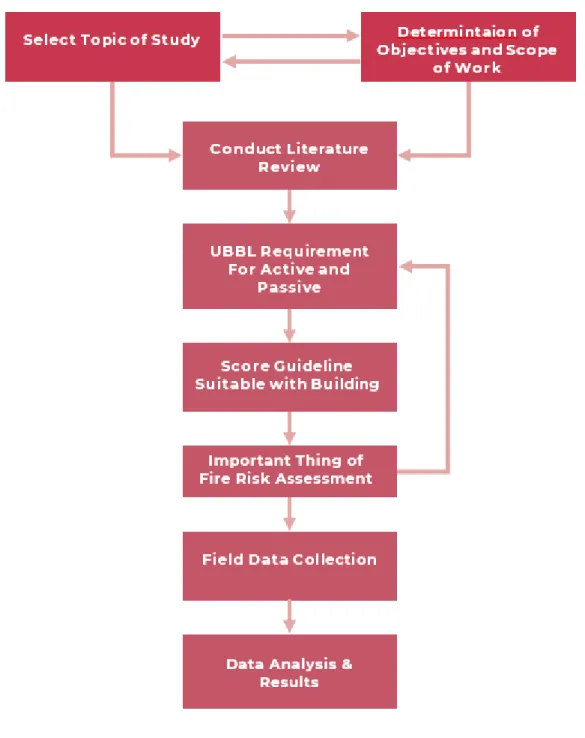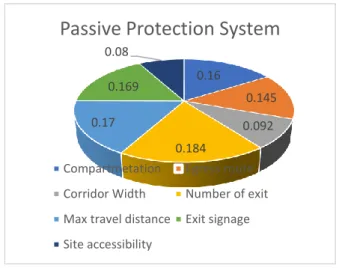Penilaian risiko kebakaran ialah pemeriksaan sistematik tentang perkara yang menimbulkan bahaya kebakaran kepada orang dalam aktiviti kerja dan tempat kerja anda. Penilaian risiko kebakaran boleh membantu mengurangkan atau mencegah kebakaran, melindungi harta benda dan kakitangan, dan mengenal pasti dan mengawal bahaya tempat kerja. Untuk menjadikan penilaian risiko kebakaran lebih cekap dan berfungsi, kadar pematuhan digunakan untuk menjadikan penilaian risiko kebakaran lebih cekap.
Dalam kajian ini, penilaian risiko kebakaran akan dijalankan di beberapa fasiliti tertentu di kampus Kejuruteraan USM iaitu perpustakaan, Fakulti Kejuruteraan Awam, Makmal Kejuruteraan Awam, Fakulti Kimia, Pusat Pengajian Kejuruteraan Mekanikal, Pusat Pengajian Kejuruteraan Awam. Bahan dan Sumber Mineral, dan Asrama Pelajar. Oleh itu, tahap pematuhan boleh membantu membandingkan penilaian risiko kebakaran dan boleh mengenal pasti faktor keselamatan. Tahap pematuhan untuk sistem perlindungan aktif dan pasif telah dicapai untuk setiap bangunan yang dipilih.
The largest compliance rate for active and passive is Library, which is 6.5877 and 2.172 respectively, as all the criteria have the highest score. Meanwhile, the lowest compliance rate was for passive School of Mechanical Engineering which is 4,334 because it has the highest distance for travel distance. The lowest asset compliance rate was Laboratory Civil which is 1.8072 due to the hose reel not complying with UBBL.
Therefore, the degree of compliance can help to compare the fire risk assessment and can know the safety factor.
INTRODUCTION INTRODUCTION
- Background of research
- Problem Statement
- Objectives
- Dissertation Outline
When fire and smoke are detected by a fire or smoke alarm, it will start operating and function to warn the occupants of the building. The fire extinguishers and a sprinkler system helped slow the growth of the fire until firefighters had a chance to arrive on the scene. A professional engineer licensed under the Registration of Engineers Act 1967 must inspect all buildings of five storeys or more and more than ten years old under Section 85A of the Street, Drainage and Building Act 1994 of the Act of Malaysia (Fui, 2021).
Most of the structures at the USM Engineering Campus in Nibong Tebal, Pulau Pinang were completed in the 1990s. All buildings were constructed in accordance with the UBBL 1984, although they have been regularly altered or renovated since then. Today's fire risk assessment method uses a checklist method, which is ineffective and difficult to comply with UBBL 1984.
The compliance scale can analyze the fire safety vulnerability for each building and can reveal the lack of active or passive protection system. Therefore, the main contribution of this research is the improvement of the fire risk assessment method which is the checklist method with the degree of compliance. By multiplying the result by the weight, the degree of compliance of the selected buildings on the USM Engineering Campus with respect to the UBBL is determined.
To evaluate the compliance rate of the selected buildings in the Engineering Campus, USM with respect to UBBL. This study starts with making analysis on fire risk assessment to the existing building at USM Engineering Campus. To achieve the objectives above, the scope of the study is as follows the study focused on the current building of fire risk based on UBBL.
Based on results of checking, we can know the condition of the building and suggest the improvement with reference to UBBL. Furthermore, this chapter provides the majority of relevant criteria in recent fire risk assessment-related research that has focused on this study. Each of the steps is explained in detail with the additional information of data collection, analysis process and presentation.
LITERATURE REVIEW
- Overview
- Background of UBBL
- Passive Protection System
- Active Protection System
- Fire Management
- Building Characteristic
- Summary
- METHODOLOGY METHODOLOGY
- Overview
- The Weightage Scale For The Passive And Active Criteria Of UBBL
- Passive Protection System
Watts & Kaplan, (2001) claimed that it is essential to analyze the fire risk in buildings to determine the consequences of the level of fire safety. It was determined that immediate intervention steps are required to improve the fire safety credentials of the observed case study structures. Ismawati & Mariati, (2013) evaluated the passive and active fire protection systems installed in buildings in accordance with the UBBL 1984 fire safety regulations and the level of knowledge of building occupants regarding the installations.
Tharmarajan, (2007) identified the components of fire safety management that have an impact on the fire safety of high-rise building occupants. Even when tall structures are equipped with the most advanced fire safety measures, the safety of the building's occupants remains questionable. Fire outbreaks are caused by human reasons such as carelessness, ignorance or a lack of fire safety awareness.
A fire safety rating system (EB-FSRS) is proposed by (Chow, 2002) for evaluating the fire safety provisions of existing non-residential high-rise buildings in Hong Kong. The architectural features, interior details and fire safety measures of 37 old high-rise buildings were analysed. During the transition period, proper fire safety management can be created based on the scores.
The passive building construction, active fire protection measures (installation of fire services) and critical risk factors are all in accordance with local fire safety laws. As a result, the total fire safety score (total final score from criteria 1 to criteria 4) is 5.40 which is in the middle range. Hou, (2018) identified the condition of fire safety aspect and suggested the measures to improve the fire safety aspect for active and passive in the high rise residential buildings.
Ibrahim et al., (2011) conducted research on the creation of a fire risk assessment technique for historical structures. The plan outlines methods for effective fire safety management to prevent fires and protect people and property in the event of a fire. The plan should detail the organization, planning, monitoring, control and evaluation of fire safety procedures and provisions in the building.
Housekeeping and maintenance, a management fire safety plan, security, staff training, a firefighter or marshal, emergency response and exterior exposure to fire are the most important aspects of a fire management system according to previous research (Ibrahim et al., 2011). Once completed, the second phase would be to conduct a literature search to find more information on fire risk assessment and fire safety in general and to find the weight of fire risk assessment criteria, thus achieving part of the first objective.
